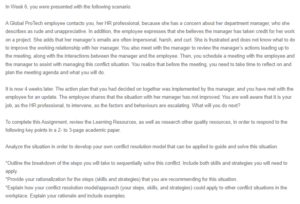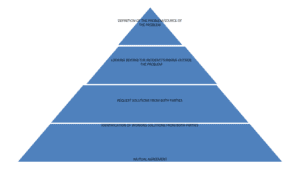Strategies for Conflict Resolution at the Workplace
Introduction
Conflicts at places of work arise from differences in employees’ personalities, goals, and opinions. Mostly, these conflicts are not physical but take forms such as insults, anger, non-cooperation, and personal clashes among employees (Lamare, 2020). There is a need for conflict resolution since continued conflicts at work can lead to poor productivity, failure of projects, and work disruptions. HR is responsible for assessing the differences and mistakes to come up with solutions that intend to restore and build good working relations of employees at places of work (Smith, 2018). In this case, I intend to solve the conflict between the employee and her manager for the second time. The first time’s conflict resolution strategy did not work because I did not involve the two parties. This time around, my conflict resolution model will take the five steps as illustrated below.
Fig. 1 Five strategies for conflict resolution.
Step 1: Definition of the problem.
I intend to get more information about the origin of the conflict so that it can help me solve the problem. My strategy at this early stage will be to ask several questions to understand the root cause of the conflict. I will ask questions like, “when did the problem start?” “Why do you think that the messages are harsh?” “Do you think that the messages are not impersonal?” “What do you think might be leading to this incident?” “Is there any other relationship between the two of you apart from work relationship?” through these series of questions, I would have given both parties a chance to share their grievances as I get to understand the problem. As they respond to inquiries, I will be acknowledging to encourage them to open up more issues to me (Lamare, 2020).
Step 2: Thinking outside the problem
I will look beyond the incident. According to the answers provided in step 1, I would have understood the root cause of the problem. In addition, supportive questions such as, “What happen here?” “When did it first begin, and who started it?” these questions will trigger the real cause of the problem. This will help me understand the level of stress between the two parties.
Step 3: Request solutions from both parties
Upon hearing views from both parties, I will request them to identify how to rectify the existing situation. Questions such as, “How do we make things work as they used to be?” I will listen keenly to the answers provided to this question by both parties. I will also watch their moods based on the solutions they will give.
Step 4: Identification of working solutions from both parties.
I will take solutions that have some element of commonality so as not to favour either party. After listening to the solutions provided in step 3, I will analyze the advantages of various ideas to the organization and the employees before implementation (Doyle, 2019). My strategy will consider suggestions that advocate for intensive cooperation and collaboration among employees to solve departmental conflicts.
Step 5: Mutual agreement
I will get the two parties to shake hands as they accept one of the solutions derived in step 4. In addition, I will request them to give action plans that the organization can put in place so as to prevent conflicts in the future. Finally, I will write a contract for both parties to sign upon violation legal consequences will follow as per the organization’s constitution.
How my conflict resolution model can apply in workplaces
This is a five-stage model for solving workplace conflicts. It is supportive to both employees and management staff without favouring either party. It is applicable to any workplace where the management team responsible for conflict resolution understands the criteria behind the model and is ready to implement it. The model analyzes the problem and then comes up with the solution. For example, personal differences between managers and junior staff can cause conflicts. To handle this personality problem between the manager and the junior staff, place the employee under the supervision of a different manager to avoid losing an experienced/good workforce.
Conclusion
A good conflict resolution strategy does not only focus on bringing the parties together but also should reach the final verdict. Organizations should adopt approaches that lead to more lasting solutions when solving conflicts at their place of work. A good strategy should give both parties equal chances to present their grievances in the process of conflict resolution
References
Doyle, A. (2019, June 17). Conflict resolution: Definition, process, skills, examples. The Balance Careers. Retrieved from https://www.thebalancecareers.com/conflict-resolutions-skills-2063739
Liddle, D. (2017). Managing conflict: A practical guide to resolution in the workplace. Kogan Page.
Lipsky, D. B., Avgar, A. C., & Lamare, J. R. (2020). Organizational conflict resolution and strategic choice: Evidence from a survey of Fortune 1000 firms. ILR Review, 73(2), 431-455.
Smith, G. P. (2018, February 28). Conflict resolution: 8 strategies to management workplace conflict. Business Know-How. Retrieved from https://www.businessknowhow.com/manage/resolveconflict.htm
ORDER A PLAGIARISM-FREE PAPER HERE
We’ll write everything from scratch
Question

Strategies for Conflict Resolution at the Workplace
In Week 6, you were presented with the following scenario:
A Global ProTech employee contacts you, her HR professional, because she has a concern about her department manager, who she describes as rude and unappreciative. In addition, the employee expresses that she believes the manager has taken credit for her work on a project. She adds that her manager’s emails are often impersonal, harsh, and curt. She is frustrated and does not know what to do to improve the working relationship with her manager. You also meet with the manager to review the manager’s actions leading up to the meeting, along with the interactions between the manager and the employee. Then, you schedule a meeting with the employee and the manager to assist with managing this conflict situation. You realize that before the meeting, you need to take time to reflect on and plan the meeting agenda and what you will do.
It is now 4 weeks later. The action plan that you had decided on together was implemented by the manager, and you have met with the employee for an update. The employee shares that the situation with her manager has not improved. You are well aware that it is your job, as the HR professional, to intervene, as the factors and behaviours are escalating. What will you do next?
To complete this Assignment, review the Learning Resources, as well as research other quality resources, in order to respond to the following key points in a 2- to 3-page academic paper.
Analyze the situation in order to develop your own conflict resolution model that can be applied to guide and solve this situation.
*Outline the breakdown of the steps you will take to sequentially solve this conflict. Include both skills and strategies you will need to apply.
*Provide your rationalization for the steps (skills and strategies) that you are recommending for this situation.
*Explain how your conflict resolution model/approach (your steps, skills, and strategies) could apply to other conflict situations in the workplace. Explain your rationale and include examples.


